« September 18, 1971 – Utah at Oregon »
 October 12, 2011
October 12, 2011 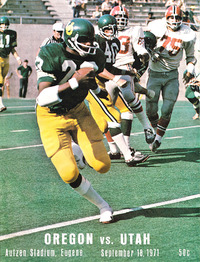 click to embiggenJerry Frei wasn’t happy. Called his team “sloppy.” Said “we should have scored at least nine touchdowns.”
click to embiggenJerry Frei wasn’t happy. Called his team “sloppy.” Said “we should have scored at least nine touchdowns.”
Bobby Moore was unimpressed. “I thought I had a good game but not a great game… I should have had a better burst of speed.”
Utah coach Bill Meek played it right down the middle. “I was pleasantly surprised that our young offensive personnel moved the ball, but I didn’t think we’d get cut up that bad on defense.”
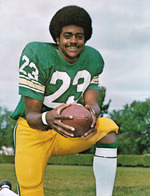 Bobby Moore, now Ahmad Rashad, 1971The fans, generously counted at 27,000, at Autzen Stadium for the first night game in school history should have been dancing in the aisles about the offensive explosion of the Fighting Ducks. The home team led 20-7 after barely five minutes had elapsed. Moore broke Jim Shanley’s school record for rushing yardage, with 249 on just 27 carries, and gathered in three passes for 89 yards and a TD; a phantom clipping penalty cost him another 35 yard TD run. Enormous fullback Greg Herd battered the Utah line. Dan Fouts threw with reasonable efficiency (18-32-1 for 245 yards and three TDs).
Bobby Moore, now Ahmad Rashad, 1971The fans, generously counted at 27,000, at Autzen Stadium for the first night game in school history should have been dancing in the aisles about the offensive explosion of the Fighting Ducks. The home team led 20-7 after barely five minutes had elapsed. Moore broke Jim Shanley’s school record for rushing yardage, with 249 on just 27 carries, and gathered in three passes for 89 yards and a TD; a phantom clipping penalty cost him another 35 yard TD run. Enormous fullback Greg Herd battered the Utah line. Dan Fouts threw with reasonable efficiency (18-32-1 for 245 yards and three TDs).
The total effort: 615 yards, another school record.
And yet, with under four minutes left, Oregon had its “hands” team waiting for an onside kick, from the backup kicker for the Redskins, leading by just seven points… and watched in horror as tiny reserve QB Harvey Winn muffed the catch; Scott Robbins recovered the ball for Utah, and they were in business again at midfield with momentum, along with three timeouts to work with.
That the game would come down to a final heroic defensive stand for Frei’s best offensive team was just another irony. Going into his fifth season at the helm, Jerry Frei finally had a respectable talent base. But most of that talent was on the offense. Fouts, Moore and tackle Tom Drougas would go on to lengthy NFL careers, but only linebacker Tom Graham would receive honors on the defensive side. All that scoring ability was the key to success, because the Ducks couldn’t stop anyone.
Preseason, the Ducks were talking Rose Bowl. Hoots of derision were strangely absent. The offense really did look like it could outscore anyone, but the Achilles heel was Oregon’s schedule, considered the nation’s toughest; opener at Nebraska (the eventual national champions), back home for a Utah team that had gone 6-4 in ‘70, then on the road at defending Pac-8 champion Stanford, then to Austin for a game at defending SWC champion Texas, which hadn’t lost at home in four seasons, then to Los Angeles for a date with USC. Pundits looked at that opening month and said if Oregon could get through the first four games at 1-3 and without serious injury, they’d have a shot at Pasadena.
Oregon may have the most potent offense in the country, but it is going to take more than that to get the Ducks through the first half of the 1971 season unscathed. Your prayers would help … Frei has tremendous offensive weapons, an improved defense led by All-American linebacker Tom Graham, a lot of hope and a happy football team.
“In these trying times, do not sell that last point short.” – Al Moss, San Francisco Chronicle
The “1” in that 1-3, of course, was Utah. And the Ducks needed all those yards, the magnificent performance by Moore, and that last stand on defense to come out on top, 36-29.
***
As predicted, Oregon started 1971 at 1-3, drubbed at Nebraska and Texas. But the ship was righted in a win over USC – the first in Los Angeles since the 1957 Rose Bowl season. A win over the Huskies at Autzen, when LB Bill Drake broke a fingernail deflecting a winning FG attempt, and suddenly Oregon was 2-1 in conference play. No UCLA on the schedule, and the remaining three conference opponents were considered eminently beatable… and Wazzu had shocked the world, and Stanford, with a 24-23 win that left five teams tied for first place. Oregon was one of them. It was the latest the Ducks had remained in Rose Bowl contention in a season since 1964.
The exalted status didn’t last. In Pullman, the Ducks blew a fourth-quarter lead, giving up a TD on a fake punt and another score following a Fouts interception, and put WSU into the Rose Bowl driver’s seat. A foggy win at Air Force put Frei’s charges at 5-4, facing two critical games, Cal and OSU, both at Autzen. Two wins could be reasonably expected; certainly one was likely. They lost both. The boosters started pulling strings, and in late January of 1972, Frei resigned in frustration.
***
Program Notes:
- This program appears courtesy of Terry Frei, son of Jerry, a noted sportswriter and author currently living in Colorado. Terry is the author of two interesting and relevant books for Oregon fans: “The Witch’s Season” is a fictionalized chronicle of the turmoil in and around the UO and the Duck football program in the late Sixties; “Third Down and a War to Go” traces the story of Jerry Frei and his Wisconsin teammates who left school in 1942 after winning a national championship to serve their country in World War II. Both are well worth reading.
- Bobby Moore, now known as Ahmad Rashad, was named the AP National Back of the Week for his performance against Utah.
- Traffic was a nightmare for this game. A log truck had lost its load on the Ferry Street Bridge on Friday, damaging the roadbed, and the bridge was closed. In the days before the Wash-Jeff viaduct was constructed, there were only two ways to get to Autzen if Ferry St was shut down – Club Road, via Coburg Rd from the north, or Centennial Blvd from the Springfield side. Both routes were jammed, and the chaos was said to have contributed to the disappointing gate for the home opener.
- The program is huge – 50 pages – and jammed with photos and useful information. There’s even a current Pac-8 standings and conference schedule, along with the schedule for the Ducks – including the freshman team! – and ticket prices for all games. (Civil War: $7)
- Beano Cook contributes an interesting look at how ABC handled scheduling of televised games in 1971. (“No team can appear more than four times in two years, or more than three times in one year… No team can appear on national TV more than two times in one year…”) Yeah, the good old days.
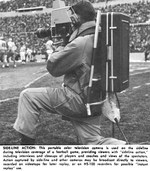 The technology of “Instant Replay” gets a two-page study, on its fifth anniversary.
The technology of “Instant Replay” gets a two-page study, on its fifth anniversary. - Check out the photo of Bobby Moore carrying the ball on page 16. Ignore the poor ball security. Focus on all that standing water. The first AstroTurf, laid down in 1969 to replace the failed grass field, was dreadful – thin carpet over concrete was how players described it – and had terrible drainage. Rooster tails were common sights on wet Saturdays.
- Best ‘fro: Linebacker Bob Green, #46 (page 15). Bobby Green was a Lane County Commissioner for 13 years.
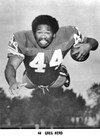 Best pose: Fullback Greg Herd, coming out of the page at you on 18. (Why don’t they pose pictures like this any more?)
Best pose: Fullback Greg Herd, coming out of the page at you on 18. (Why don’t they pose pictures like this any more?) - If you’re scoring at the game, there’s a page for “Do-It-Yourself Statistics”. Note rule #4: “Be sure to credit first downs on scoring plays originating from lines of scrimmage beyond the 10 yard line.” I’d never thought about that.
- The roster page (24) this year includes a column for “High School Coach.” A nod to recruiting? One familiar name: Tom Drougas’ coach at Sunset in Beaverton was one Darrel Davis, aka “Mouse”, originator of the run-and-shoot offense.
- Best juxtaposition of future notoriety: Page 25, O.J. Simpson at the wheel of a Chevy Vega.
- The center spread is brought to you by Hi-C, a vile canned imitation fruit drink; apparently, it’s still being manufactured, though I haven’t seen it in years. Probably popular in the SEC.
- Again, there’s a black-and-white ad for a color TV. Will they ever learn?
- Page 38 carries a report of an odd study by the UO Center of Research for Human Performance, in which eight “coeds, ranging in age from 18 to 23,” were chosen for evaluation of the response of the human body to high elevation. Dr. Eugene Evonuk, lab director, said the girls were picked because of their “good health, average physical abilities, employability, and generally stable, outgoing personalities.” Now there’s a ringing endorsement.
- New head basketball coach Dick Harter is introduced along with his assistants on page 45. The coming season is downplayed a bit, which was a good move, considering their eventual 6-20 record and 0-fer in the Pac 8.
- And what early photo of Autzen Stadium would be complete without a reminder of all the parking that used to be there? See page 50. Now those were the days.
(Note there are *two* program galleries below. Squarespace limits me to no more than 29 images per gallery. An arbitrary and capricious outrage!)
 college football programs in
college football programs in  1971,
1971,  Utah
Utah 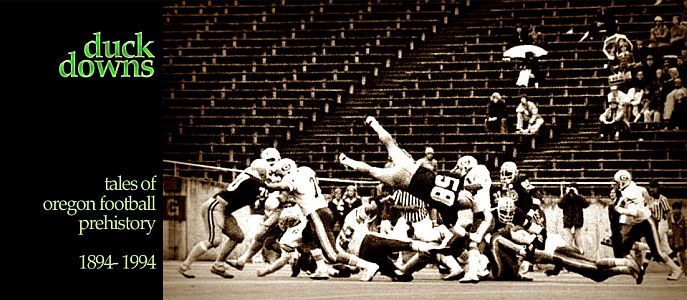
Reader Comments